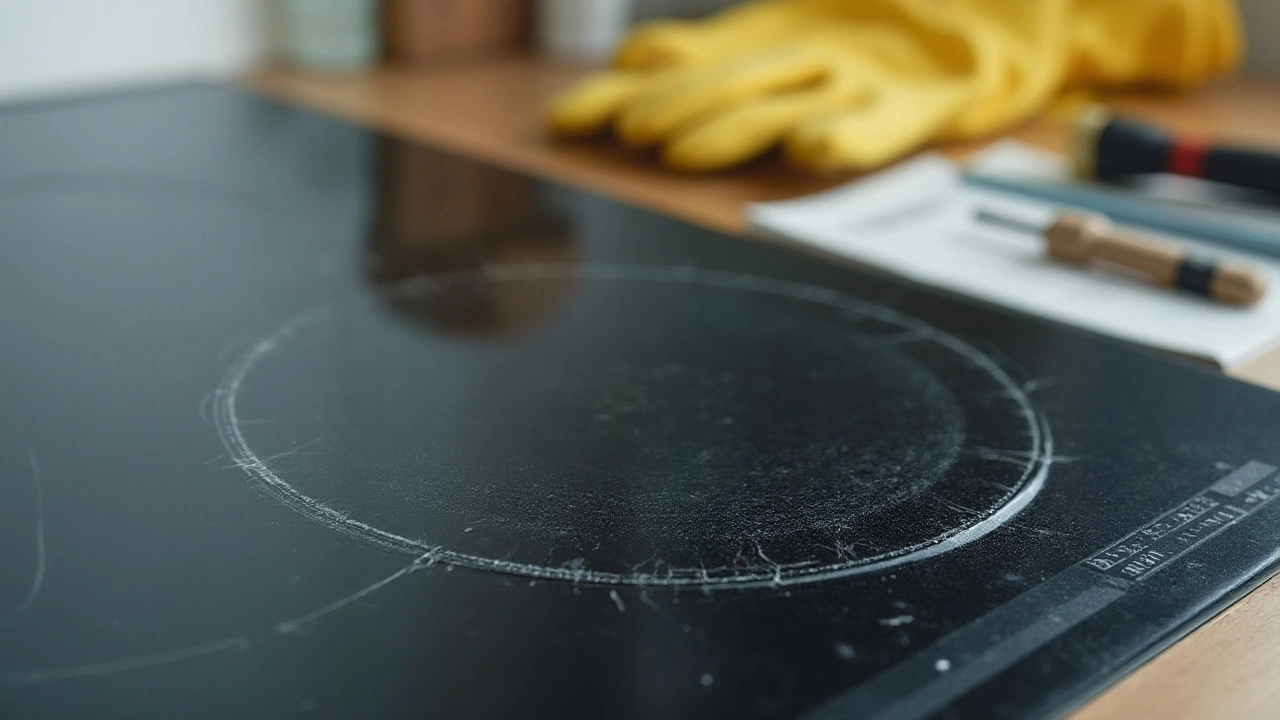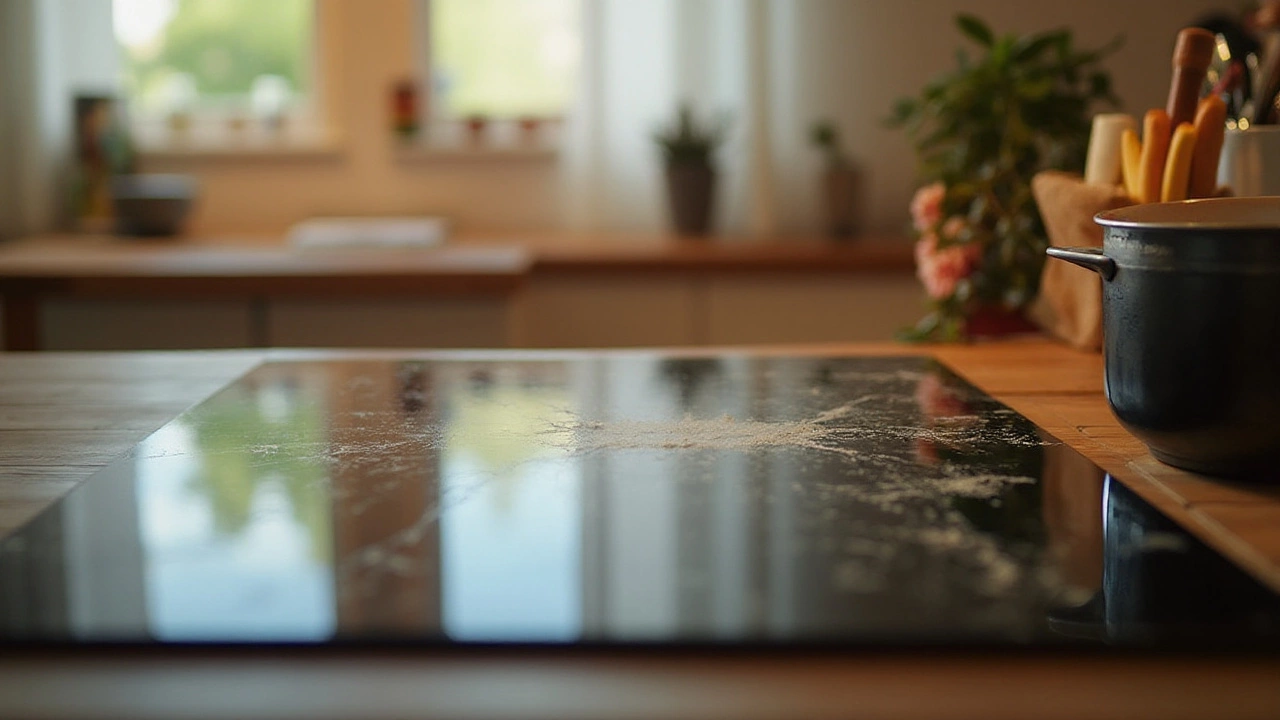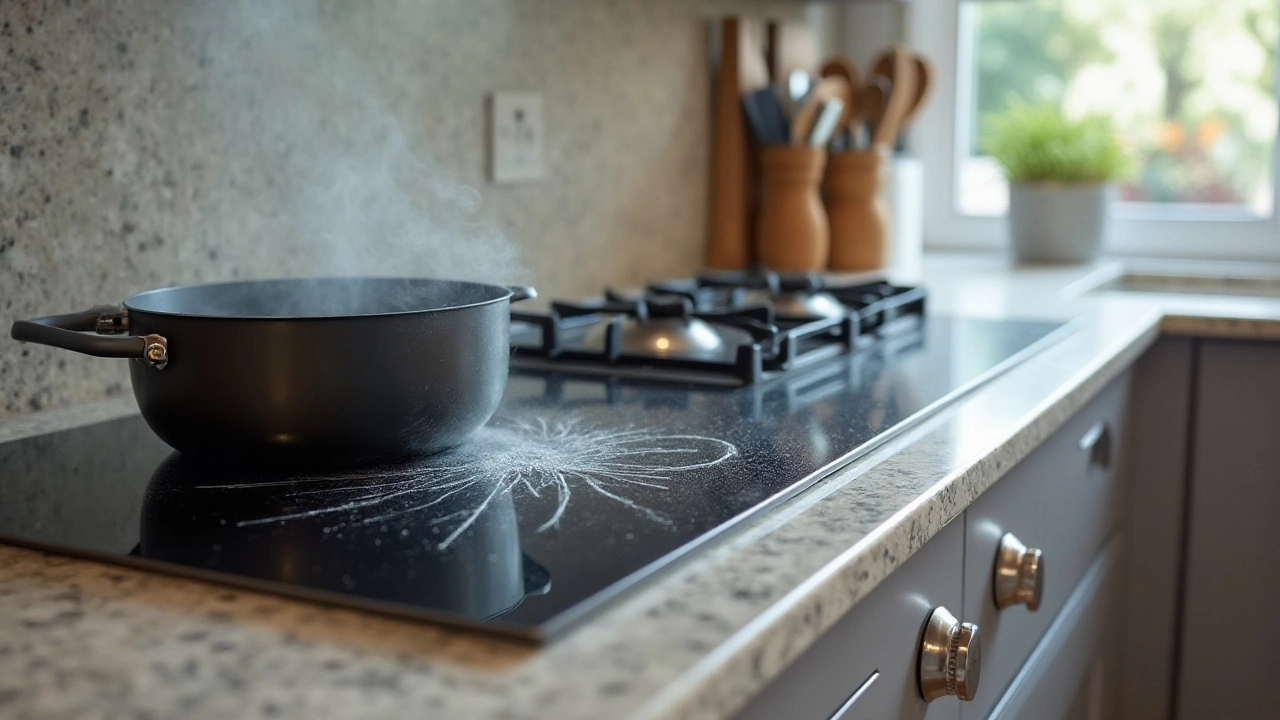Electric hobs are cherished kitchen appliances, loved for their modern look and convenience. But what happens when one day you notice a crack snaking its way across that sleek surface? It's not just an eyesore, it can affect how your hob works and might become a safety hazard.
Understanding why electric hobs crack in the first place is the first step towards tackling the problem. Various factors can contribute to this issue, ranging from sudden temperature changes to impacts from heavy kitchenware. Cracks don't always mean the end for your appliance; in many cases, prompt repair can save the day.
In this article, we will examine why these cracks appear and discuss handy repair tips and tricks. We’ll also provide some smart preventative measures, so you don’t find yourself dealing with this issue again. So, read on to keep your kitchen running smoothly and safely!
- Common Causes of Cracked Electric Hobs
- Signs You Need to Repair Your Hob
- DIY Fixes and Professional Help
- Preventative Measures to Avoid Cracks
- When to Replace Your Electric Hob
Common Causes of Cracked Electric Hobs
At first glance, a cracked hob might seem mysterious, but there are perfectly reasonable explanations for why these sleek kitchen surfaces develop splits. One prevalent cause is thermal shock. Electric hobs, consistent in delivering heat quickly, can have rapid fluctuations in surface temperature. For example, placing a cold pot directly onto a hot hob can create sudden stress across the glass-ceramic surface. The material, though designed to withstand heat, sometimes succumbs to these pressures, leading to unsightly cracks.
But thermal shock isn't the only culprit. Improper installation can be another source of trouble. When a hob is not installed with the correct supportive structure, the weight is unevenly distributed. This oversight might not become evident immediately but can take its toll over time. Even placing a hob on a surface with a slight slope or unrecognized bump can contribute to stress points where cracks can form under sustained use. Experts stress the importance of professional installation to avoid future headaches.
Accidents in the kitchen, too, are not uncommon. Imagine a heavy object, like a cast-iron skillet, slipping from your hands and landing squarely on your electric hob. Such incidents can lead to immediate and noticeable damage. Even minor hits or continuous impacts from utensils thrown into nearby drawers can contribute. The kitchen can be a chaotic orchestra of clamor, but care should be taken around these delicate surfaces.
Dave Arnold, a well-regarded figure in kitchen innovation, once said, "The key to preserving your kitchen's heart is maintaining respect for both its power and vulnerability." This rings especially true for electric hobs, which require both gentle handling and attentive observation.
Lastly, the materials from which these hobs are made can sometimes contain defects, though it's rare. Most manufacturers undergo stringent quality checks, yet occasional errors do slip through. Even a minuscule air bubble trapped during manufacturing can become a weak point when subjected to heat and pressure changes frequently. While most warranties cover such defects, it's essential to understand the terms just in case.
In conclusion, understanding the causes of a cracked hob involves considering all possible angles – from temperature changes and accidental impacts to installation woes and rare manufacturing defects. By keeping these factors in mind, you can avert potential issues, ensuring a long-lasting and efficient cooking surface in your home.
Signs You Need to Repair Your Hob
Your electric hob is at the heart of kitchen creativity, but every appliance has its limits. When it comes to detecting signs that your hob is in need of some TLC, vigilance is key. A crucial yet often overlooked indicator is the hob's heating performance. You start noticing that it takes unusually long for the hob to heat up. The once boiling affair of pasta now seems more like waiting for paint to dry. Inconsistent heating is not just an inconvenience; it's a clear signal that something isn’t quite right beneath the surface.
Another telltale sign of trouble is visible damage. Cracks, no matter how small, should raise alarms. What starts as a slight fissure can rapidly escalate into a wider fracture, posing a significant safety hazard. Leveraging this visual cue early can save you from bigger headaches down the line. Use a magnifying glass to inspect the surface more closely. Surprisingly, tiny cracks might not impact functionality immediately but they compromise the stability and longevity of your appliance.
Faint burning smells or unusual sounds are less apparent cues but equally important. These often suggest electrical faults or damage within the internal wiring of the hob. When you're making a cheese toastie and notice a lingering electric odor, don't dismiss it as overcooked bread. The scent might be trying to tell you something more consequential.
According to Kitchen Safety Alliance, "Ignoring electrical warnings like strange smells can spell disaster, potentially leading to appliance breakdown or even electrical fires."Keeping your senses alert to such red flags can prevent accidents before they happen.
Uneven cooking is another sign to heed. If your favorite onion sauté leaves some pieces charred while others remain raw, the hob is sending distress signals. It could be an issue with the hob's heating elements. Consistent performance is the mark of a healthy hob, so when unpredictability creeps in, it’s time to consider repairs. Lastly, pay attention to any error codes flashing on the hob's display. Most modern electric hobs come equipped with diagnostic features that provide codes when something is amiss.

DIY Fixes and Professional Help
Sometimes, a crack on your electric hob appears minor, and you might be tempted to fix it yourself. However, it's crucial to start by assessing the extent of the damage. Minor surface-level cracks can often be managed at home, but deeper fissures usually require professional attention. The first step in a DIY approach is ensuring the hob is completely switched off and disconnected from the power supply. Safety should always be your top priority when dealing with electrical appliances.
For those superficial cracks, a modest DIY fix involves using a special kind of heat-resistant adhesive. Clean the affected area thoroughly to remove grease and dust, as it can affect the adhesive's efficiency. Apply the adhesive carefully and allow ample drying time as per the product’s instructions. While this only provides a temporary fix, it can buy time until you decide on the next steps. Keep in mind, not all cracks are safely manageable at home; if in doubt, always aim for professional repair services.
Engaging a professional has its perks, especially when the hob's glass is shattered or deep cracks threaten functionality and safety. Professionals not only come with the right tools but also with a wealth of experience and can ensure that your hob is restored without voiding any warranties. Some repairs may be covered under warranty, so check your appliance's paperwork before hiring a technician. "Preventive maintenance can often extend the life of appliances," says appliance expert John Harrison.
Complex issues are best handled by professionals to ensure safety and maintain appliance efficiency.
When selecting a repair service, do some groundwork by checking online reviews or asking for recommendations from friends and family. Comparing quotes and understanding the repair scope can also save unnecessary expenses. Keep an eye out for professionals who offer a service guarantee as a sign of trustworthy work. Remember, while a DIY solution seems instantly gratifying, professional help often proves long-lasting and secure, making it the smarter choice for significant damage. At times, prompt intervention by an expert can also prevent further detriment, translating into lower future repair costs.
There’s solid value in balancing self-led initiatives with professional expertise. A suitable blend can keep your electric hob running safely and smoothly. DIY repairs serve as quick fixes, but frequently, professional assistance ensures peace of mind, particularly for major repairs or replacements. By following these tips, your kitchen appliance will not only look better but will continue to perform optimally without pressing interruptions.
Preventative Measures to Avoid Cracks
A cracked electric hob can not only disrupt the functionality of your kitchen but can also become a hazard if left unchecked. Therefore, maintaining your hob in good condition is crucial. One of the primary ways to prevent cracks is by understanding and avoiding thermal shock. This occurs when the hob surface is exposed to rapid temperature changes. By allowing the hob to heat more evenly, you can avoid this common pitfall. Always start your cooking at a lower heat setting and gradually increase the temperature rather than shocking it with sudden heat. Additionally, avoid placing extremely cold pots on a hot hob, as this can stress the material, encouraging cracks to form.
Installing the hob securely is another essential preventative measure. An uneven surface or a loosely fitted hob can wobble during usage, which places undue stress on the surface, potentially leading to cracks. Ensure that your hob is installed on a level countertop. Regularly check for any loose fittings and tighten them where necessary. While adjusting settings or cleaning, handle the device with care to prevent knocking against the hob, which can eventually compromise its structural integrity.
Proper usage of cookware is also essential. Opt for flat-bottomed pans that provide even contact with the hob surface, as this helps to distribute the heat more evenly and minimizes the risk of stress fractures. Avoid cooking with pots and pans that have rough or sharp edges, as these can sometimes scrape against the hob and create microfractures that eventually develop into larger cracks. When cleaning, use non-abrasive materials and specialized cleaners intended for smooth surfaces to preserve the integrity of the glass or ceramic finish.
Educating all kitchen users about correct hob care can significantly reduce accidental damage. Instituting a culture of gentle use and careful handling can prevent many avoidable issues. Regular maintenance checks can also be invaluable. During these checks, inspect the hob for signs of stress or minor cracks that might require attention.
"A stitch in time saves nine," is true here, as early repair can mitigate the need for full replacements later on, emphasizes appliance repair expert John Davies.
Sometimes unavoidable kitchen mishaps can occur. Thus, knowing how to react can reduce the impact of accidents. For example, keeping a hob protector mat can serve as an additional layer of defense against dropped items or spillages. These mats can absorb some of the force from objects and help contain spills, thereby protecting your hob's surface. To manage these occurrences swiftly, have a well-stocked kitchen toolkit with essential items like screwdrivers, sponges, and appropriate cleaning solutions at hand for quick fixes.

When to Replace Your Electric Hob
Electric hobs are designed to be durable and reliable, serving as the culinary heart of the kitchen. However, even the sturdiest appliances have a lifespan, and knowing when it's time to replace your beloved hob is crucial for maintaining both functionality and safety in your cooking space. A major indicator that a replacement is inevitable is persistent or worsening cracks in the hob's surface. These imperfections are more than just cosmetic; they can lead to uneven cooking, energy inefficiencies, and even pose serious safety risks like electrical hazards or glass shattering unexpectedly. Cooking on a compromised surface can be risky business, as heat distribution becomes inconsistent, potentially leading to poorly prepared meals or dangerous hot spots.
Another clear signal of a hob nearing the end of its road is repeated electrical problems. Flickering, inconsistent heating, or complete power loss in segments of the hob often suggest underlying electrical faults that could render the appliance both inefficient and unsafe. In these cases, continuous repair work can add up quickly, often making a replacement more cost-effective in the long run. Moreover, if your hob experiences frequent shutdowns or trips the circuit breaker, it might be a symptom of an internal failure demanding attention beyond simple fixes. These electrical issues compromise not just your cooking convenience but also heighten the risk of short circuits or fire hazards, necessitating immediate and serious consideration towards a complete replacement.
In the ever-evolving world of kitchen technology, energy efficiency plays a significant role. Older electric hobs might not meet modern efficiency standards, leading to increased energy consumption and, subsequently, higher electricity bills. Newer models are designed with advanced energy-efficient technologies that can significantly reduce your carbon footprint and utility expenses. Thus, if your hob is of a certain vintage and is guzzling energy, it might be time to upgrade.
It's also worth considering the market for new electric hobs and the advances they bring in performance and safety features. Contemporary models often incorporate smart sensors, touch controls, and connectivity options that older models simply cannot match. For many homeowners, the benefits of an upgrade include more consistent cooking, quicker heating times, and additional safety mechanisms like automatic shut-offs. These features not only enhance the cooking experience but also provide peace of mind for families, particularly those with curious young children at home.
Renowned appliance expert, Linda Harris, once said, "A well-timed upgrade not only enriches your culinary adventures but ensures your kitchen remains a safe and efficient haven for all household activities."
Lastly, aesthetics and kitchen design aspirations also come into play. A cracked or outdated hob can detract from your kitchen's overall appeal. Modernizing your hob could seamlessly bring your kitchen decor together, blending style with functionality. Replacements are not just motivated by necessity but also by the desire for harmony and elegance in an increasingly design-conscious world.


